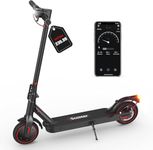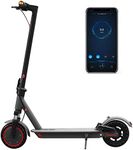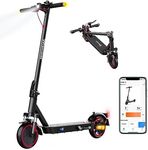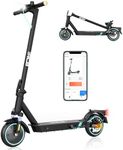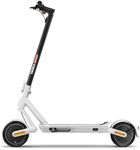Buying Guide for the Best Budget Electric Scooter
Choosing the right budget electric scooter involves understanding your needs and matching them with the key specifications of the scooter. It's important to consider where and how often you'll be using the scooter, as well as your personal preferences for speed, range, and comfort. By focusing on the key specs, you can find a scooter that offers the best balance of performance, convenience, and value for your specific situation.Battery Life and RangeBattery life and range determine how far you can travel on a single charge. This is crucial if you plan to use the scooter for commuting or longer trips. Scooters with a range of 10-15 miles are suitable for short, occasional rides, while those with 15-25 miles are better for regular commuting. If you need to travel longer distances, look for scooters with a range of 25 miles or more. Consider your daily travel distance to choose the right range for you.
Motor PowerMotor power, measured in watts, affects the scooter's speed and ability to handle inclines. Lower power motors (around 250 watts) are adequate for flat terrains and lighter riders. Mid-range motors (350-500 watts) offer better performance for moderate hills and heavier riders. High power motors (500 watts and above) are ideal for steep inclines and faster speeds. Choose motor power based on the terrain you'll be riding on and your weight.
Top SpeedTop speed indicates how fast the scooter can go. For casual rides or short commutes, a top speed of 10-15 mph is usually sufficient. If you need to cover longer distances quickly, look for scooters with top speeds of 15-20 mph. Always consider local regulations regarding speed limits for electric scooters in your area.
Weight and PortabilityThe weight of the scooter affects its portability and ease of use. Lightweight scooters (under 25 lbs) are easier to carry and store, making them ideal for short commutes and public transport. Mid-weight scooters (25-35 lbs) offer a balance between portability and stability. Heavier scooters (over 35 lbs) are more stable and durable but can be cumbersome to carry. Consider how often you'll need to carry the scooter and choose accordingly.
Build Quality and DurabilityBuild quality and durability ensure the scooter can withstand regular use and various weather conditions. Look for scooters made from high-quality materials like aluminum or steel, which offer better longevity. Check user reviews and ratings to gauge the scooter's reliability. If you plan to use the scooter frequently or in rough conditions, prioritize durability.
Braking SystemThe braking system is crucial for safety. Electric scooters typically have one or more types of brakes: foot brakes, drum brakes, disc brakes, or electronic brakes. Foot brakes are basic and suitable for low speeds. Drum and disc brakes offer better stopping power and are ideal for higher speeds and frequent use. Electronic brakes provide additional stopping power but are usually used in combination with other brake types. Choose a braking system that matches your riding speed and safety needs.
Tires and SuspensionTires and suspension affect ride comfort and handling. Solid tires are puncture-proof and low maintenance but offer a rougher ride. Pneumatic (air-filled) tires provide better shock absorption and a smoother ride but require more maintenance. Suspension systems (front, rear, or both) further enhance comfort by absorbing shocks from uneven surfaces. If you'll be riding on rough or uneven terrain, prioritize scooters with pneumatic tires and good suspension.
Additional FeaturesAdditional features like lights, display screens, and app connectivity can enhance your riding experience. Lights are essential for visibility and safety, especially if you ride at night. Display screens provide useful information like speed, battery level, and range. App connectivity can offer features like GPS tracking, ride statistics, and remote locking. Consider which additional features are important to you and choose a scooter that includes them.
